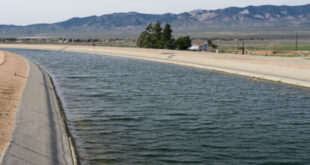The Bureau of Reclamation has released updated projections of reservoir levels within the Colorado River system over the next five years. The new projections unfortunately showed continued elevated risk of Lake Powell and Lake Mead reaching critically-low elevations as a result of the historic drought and low-runoff conditions in the Colorado River Basin.
Lake Powell Projections
At Lake Powell, the projections indicate the potential of falling below minimum power pool as early as July 2022 should extremely dry hydrology continue into next year. Beyond 2022, the chance Lake Powell could fall below minimum power pool ranges from about 25% to 35%. Elevation 3,525 feet, the target elevation in Lake Powell, has an almost 90% chance of being reached next year. That target elevation provides a 35 vertical-foot buffer designed to minimize the risk of dropping below the minimum power pool elevation of 3,490 feet and balances the need to protect the infrastructure at Glen Canyon Dam and meet current operational obligations to the Lower Basin States of Arizona, California and Nevada.
“The latest outlook for Lake Powell is troubling,” said Reclamation’s Upper Colorado Basin Regional Director Wayne Pullan. “This highlights the importance of continuing to work collaboratively with the Basin States, Tribes and other partners toward solutions.”
Reclamation has begun supplemental water deliveries last July to Lake Powell from the upper reservoirs of Flaming Gorge, Blue Mesa and Navajo. Those supplemental deliveries will provide up to an additional 181 thousand acre-feet of water to Lake Powell by the end of the 2021.
Lake Mead Projections
Projections indicate the chance of Lake Mead declining to elevation 1,025 feet (the third shortage trigger) is as high as 66% in 2025, and that there is a 22% chance of the reservoir elevation dropping to 1,000 feet the same year.
“This five-year probability table underscores the need for additional actions beyond the 2007 Guidelines and the 2019 Drought Contingency Plan to be taken to enhance our efforts to protect Lake Mead, Lake Powell and the Colorado River system overall,” said Tom Buschatzke, Director of the Arizona Department of Water Resources.
Most of the flow of the Colorado River originates in the Rocky Mountains. The Upper Basin experienced an exceptionally dry spring in 2021, with April to July runoff into Lake Powell totaling just 26% of average, despite near-average snowfall last winter. Total Colorado River system storage today is 39% of capacity, down from 49% at this time last year.
To view the most recent Colorado River system projections, visit https://www.usbr.gov/lc/region/g4000/riverops/crss-5year-projections.html.
 California Water News Daily Your Source For Water News in California
California Water News Daily Your Source For Water News in California


